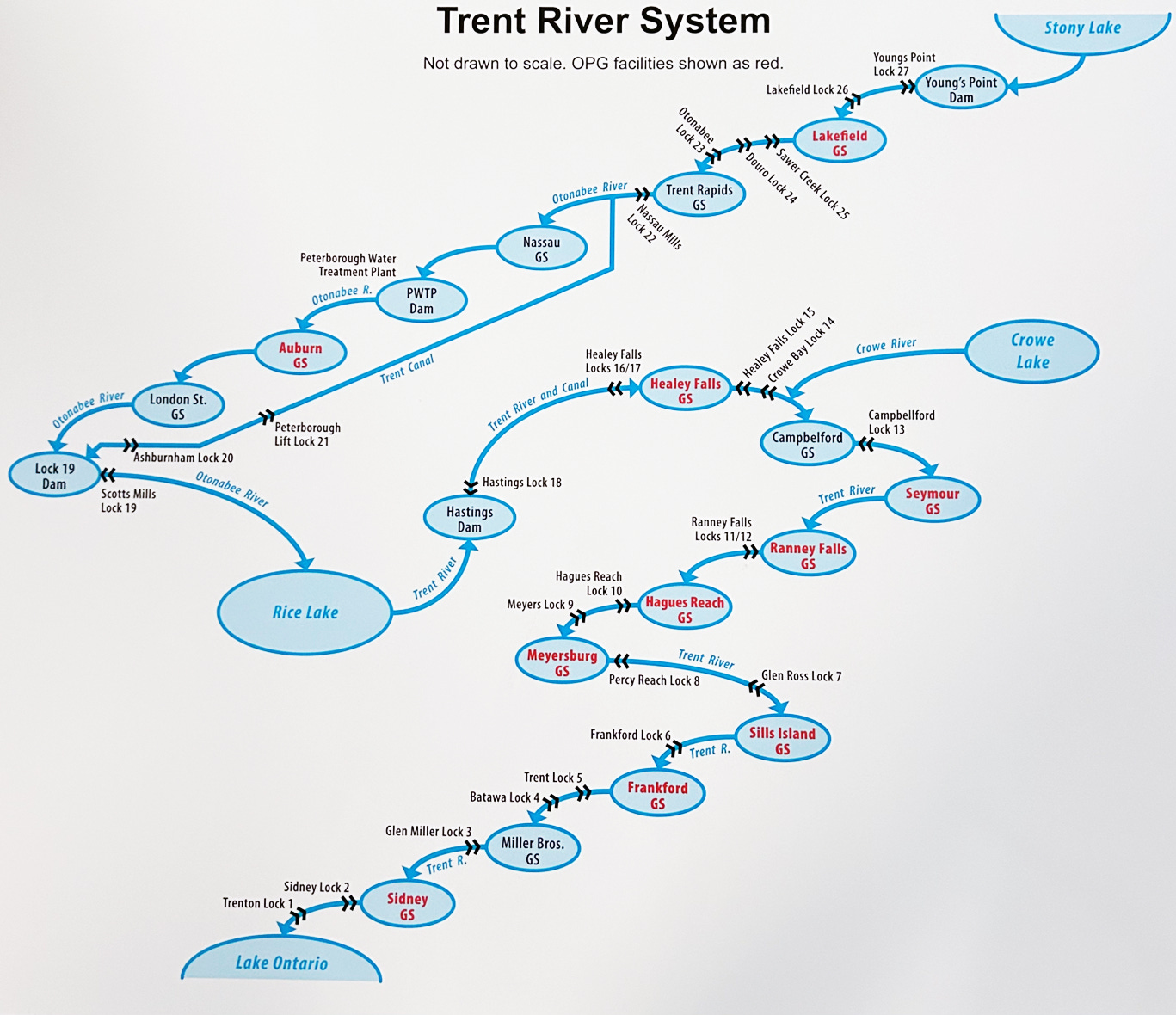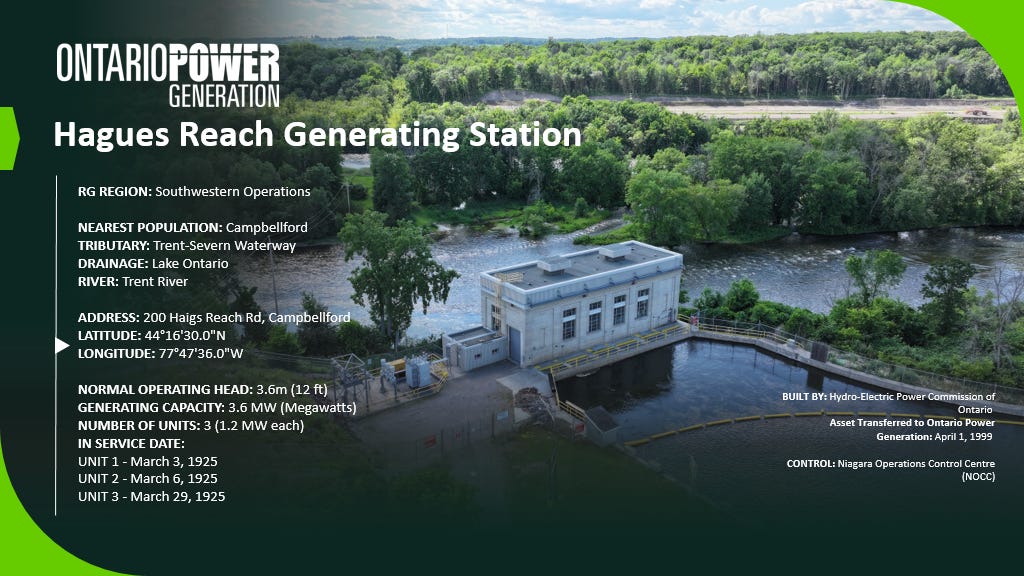Generating power for over 100 years
Six stations in Trent Hills keep spinning out electricity
Trent Hills is a leader in power generation.
No, really, it is if you look at some of the numbers in the correct light. We have six generating stations on the Trent River in our municipality; that’s one for every 2,300 residents.
Each day these stations generate enough electricity for about 10 times the number of homes that are located here. To be fair to places like Niagara Falls, most of our stations are more than 100 years old and in total they only generate a small percentage of the power produced by the giants such as Niagara or Saunders on the St. Lawrence River near Cornwall. In total, OPG has 66 hydroelectric stations that can generate 7,624 megawatts (MW) of power, so you can see that we are a small slice of the system.
But our stations have been a reliable, sustainable part of this community for decades and should be well into the future. However, they are not something we ever hear much about or think about. That was the genesis of this story.
Five of the stations are owned and operated by Ontario Power Generation (OPG) – Healey Falls, Seymour, Ranney Falls, Hagues Reach, and Meyersburg. A sixth station – Campbellford, located at Lock 14 north of town on CR 38 -- belongs to Campbellford/Seymour Electric Generation Inc., a subsidiary of Peterborough Utilities Inc., which is owned by the city of Peterborough.
A couple of weeks ago, I talked to Mark Good, Senior Manager Maintenance & Production, for OPG at Campbellford. He looks after 12 plants, which have 37 generating units. including the five stations located in Trent Hills that have 18 units.
We chatted in his office on Trent Drive where a large video screen showed the status of all generating units under his care. The units are actually controlled by an operations team in Niagara Falls. The 30 or so local employees who report to Good are responsible for maintenance and care of the stations, which extend from Merrickville, near Smiths Falls in the east, to Lakefield in the west.
Good expresses admiration for the engineering and manufacturing ability our ancestors showed. The local units are operating with machinery that is now over 100 years old.
“These stations are like work horses and their units just purr along,” Good says. “The old school of engineering maybe wasn't as efficient, but it definitely is nice and reliable.
“We're just custodians here and we've got to give credit to the people who looked after them in the past,” he says. “They've worked well. They looked after them. We're trying to keep them going and modernize them a bit better.”
OPG has tried to improve conditions for staff by doing things like replacing fans in some control rooms with air conditioning and providing better washrooms and lunchrooms, he says.
One unit in Meyersburg is out of commission for 10 to 12 months because the generating unit is being rewired for the first time ever. Routine maintenance includes replacing elements such as bearings that wear out every 15 years or so.
An example of the challenges that current engineers face is the ongoing effort to update the Ranney Falls Generating Station. A $77-million program was started in 2017 to replace an outdated small unit with a new 10 MW unit.
A new generator was installed in September 2020, but “the generator sustained damage and commissioning activities were halted,” OPG said in its 2021 financial reports.
That problem meant the generator had to be removed and sent back to the manufacturer for repairs at the contractor’s expense, OPG said. In December 2021 I took a picture of the replacement unit that was blocking Trent Drive until it was installed later that month.
Good said there have been mechanical issues with the new unit that have been covered under warranty.
“They're helping just to get those bugs out and once we've got those bugs out, I'm hoping it will be a good provider of electricity for years to come,” he said. It was officially transferred to OPG in March 2023.
The new unit is a unique design. “It's like a wind turbine upside down,” Good says. “The generator is underwater in a bulb. You have to climb down to get access to it. You climb down a chimney 70 feet.”
Good says the OPG stations have capacity to generate up to 69 megawatts (MW) but generally with fluctuating water levels and equipment issues, they produce 50 to 55 MW. A rough rule of thumb is that one MW can serve about 1,000 homes, although that is changing as our homes use more and more electricity.
Working on the aging generating stations is a challenge for OPG staff because the units are unlike anything most have worked on before. OPG staff do most of the work on the plants, in part because it helps the company maintain the expertise needed to keep the machinery running.
“When you bring somebody new in it takes them time to get comfortable,” Good says. “They could be a very experienced mechanic or technician, but they've been working in the nuclear industry. They come here and it's a couple of years until really they start to become comfortable.”
One challenge is that each plant is different with some having horizontal generators and others vertical all made by different manufacturers back in the 1920s.
In 2000, the Harris government forced the Town of Campbellford to sell it’s 100-year-old public utility. The electrical distribution company was sold to Hydro One Networks Inc. and the electric generation corporation that operated the Campbellford generating station was sold to Peterborough Utility Services, Inc.
The $6.2 million proceeds from the sale were transferred to the Campbellford/Seymour Community Foundation. The money was split into two endowment funds -- $3.1 million to a community fund and $3.1 million to a municipal fund. Since then, the revenue generated by those funds has been used to finance annual grants.
Branches, weeds, floating toys and assorted junk often winds up captured in strainers that keep debris out of the generating units. Monitors allow the operating unit to know just how much trash is blocking an entryway. Each station is different, since they were designed and built by different owners, so operators need to learn the various ways to safely remove the debris.
Good is quick to say that safety of OPG employees and the public is his top priority.
“Our units are all run of the river,” he says, pointing out that Parks Canada actually controls the dams and water levels, so the two organizations work closely together to ensure things run smoothly.
Good says Healey Falls is the flagship station. OPG has a special contract with the Independent Electricity System Operator that oversees all generation to maintain its supply.
“Of the 12 stations that's the only one that we have a contract to be at a certain level of availability all the time and if we're not, we'd be penalized. So, we always keep that level. We don't breach the contract.”
I asked Good whether given modern technology and our need for green power it was possible to add generating capacity to our existing units. He said OPG is currently looking at the feasibility of expanding a couple of other small units down stream, but none of the ones in Trent Hills.
In case you’re wondering, you can’t request to run your home using only Trent Hills’ electricity. All the power generated here is fed into the provincial grid.
One thing that I haven’t been able to figure out, maybe some readers can help, is why Parks Canada and OPG call it the Hagues Reach lock and generating station, when the address is Haig’s Reach. That’s the sort of thing that drives aging copy editors crazy. I made a good living for years spotting those sorts of anomalies and fixing them.
You can read all Trent Hills News stories on my website here.










That's a great article promoting clean renewable energy Art, thank you. The name change has always interested me as well, Haig is a very old family name in the township. Who felt the need to change it to Hagues Reach? Same goes for the former "Heely Falls".
Good article Art. I was on council when the PUC was sold. It was my idea to create the two funds. It was the rate payers within the old town of Campbellford that paid for the electricity not the rural area. The first grant of the old Town of Campbellford went to Booth St rehabilitation. The next year I was off council and it went to Rehabilitation of Petherick Rd. In Seymour. The amalgation had just taken place and I understood that some Seymour elected officials thought they had too much of their tax dollars going to the arena. One of the comments directed to me at the time was you don,t want to share. It would be good today if the municipal portion would go into the roads in Campbellford which has the worst roads of the two urban centres. One resident said at the time there was enought money to give each rate payer in Campbellford $5,000 dollars. The foundation has done a lot of good with this money.